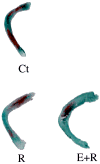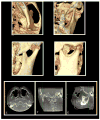TMJ disorders: future innovations in diagnostics and therapeutics
- PMID: 18676802
- PMCID: PMC2547984
TMJ disorders: future innovations in diagnostics and therapeutics
Abstract
Because their etiologies and pathogenesis are poorly understood, temporomandibular joint (TMJ) diseases are difficult to diagnose and manage. All current approaches to treatments of TMJ diseases are largely palliative. Definitive and rational diagnoses or treatments can only be achieved through a comprehensive understanding of the etiologies, predisposing factors, and pathogenesis of TMJ diseases. While much work remains to be done in this field, novel findings in biomedicine and developments in imaging and computer technologies are beginning to provide us with a vision of future innovations in the diagnostics and therapeutics of TMJ disorders. These advances include the identification and use of local or systemic biomarkers to diagnose disease or monitor improvements in therapy; the use of imaging technologies for earlier and more sensitive diagnostics; and the use of biomedicine, biomimetics, and imaging to design and manufacture bioengineered joints. Such advances are likely to help to customize and enhance the quality of care we provide to patients with TMJ disorders.
Figures








Similar articles
-
Juvenile idiopathic arthritis overview and involvement of the temporomandibular joint: prevalence, systemic therapy.Oral Maxillofac Surg Clin North Am. 2015 Feb;27(1):1-10. doi: 10.1016/j.coms.2014.09.001. Oral Maxillofac Surg Clin North Am. 2015. PMID: 25483440 Review.
-
Topical review: new insights into the pathology and diagnosis of disorders of the temporomandibular joint.J Orofac Pain. 2004 Summer;18(3):181-91. J Orofac Pain. 2004. PMID: 15508997 Review.
-
Temporomandibular joint damage in juvenile idiopathic arthritis: Diagnostic validity of diagnostic criteria for temporomandibular disorders.J Oral Rehabil. 2019 May;46(5):450-459. doi: 10.1111/joor.12769. Epub 2019 Feb 14. J Oral Rehabil. 2019. PMID: 30664807
-
Degenerative disorders of the temporomandibular joint: etiology, diagnosis, and treatment.J Dent Res. 2008 Apr;87(4):296-307. doi: 10.1177/154405910808700406. J Dent Res. 2008. PMID: 18362309 Review.
-
How do I manage restricted mouth opening secondary to problems with the temporomandibular joint?Br J Oral Maxillofac Surg. 2013 Sep;51(6):469-72. doi: 10.1016/j.bjoms.2012.12.004. Epub 2013 Feb 12. Br J Oral Maxillofac Surg. 2013. PMID: 23411470 Review.
Cited by
-
Thread Embedding Acupuncture for Temporomandibular Disorder: Protocol for a Pilot Randomized Controlled Trial.J Pain Res. 2022 Oct 13;15:3197-3207. doi: 10.2147/JPR.S383965. eCollection 2022. J Pain Res. 2022. PMID: 36267351 Free PMC article.
-
Electroacupuncture for Temporomandibular Disorders: A Systematic Review of Randomized Controlled Trials.Healthcare (Basel). 2021 Nov 2;9(11):1497. doi: 10.3390/healthcare9111497. Healthcare (Basel). 2021. PMID: 34828543 Free PMC article. Review.
-
Diagnostic index of 3D osteoarthritic changes in TMJ condylar morphology.Proc SPIE Int Soc Opt Eng. 2015 Feb;9414:941405. doi: 10.1117/12.2082226. Proc SPIE Int Soc Opt Eng. 2015. PMID: 26709325 Free PMC article.
-
Deep negative volume segmentation.Sci Rep. 2021 Aug 11;11(1):16292. doi: 10.1038/s41598-021-95526-1. Sci Rep. 2021. PMID: 34381093 Free PMC article.
-
Equine Models of Temporomandibular Joint Osteoarthritis: A Review of Feasibility, Biomarkers, and Molecular Signaling.Biomedicines. 2024 Feb 28;12(3):542. doi: 10.3390/biomedicines12030542. Biomedicines. 2024. PMID: 38540155 Free PMC article. Review.
References
-
- LeResche L. Epidemiology of temporomandibular disorders: implications for the investigation of etiologic factors. Crit Rev Oral Biol Med. 1997;8:291–305. - PubMed
-
- Gelb H, Bernstein IM. Comparison of three different populations with temporomandibular joint pain-dysfunction syndrome. Dent Clin North Am. 1983;27:495–503. - PubMed
-
- Rieder CE, Martinoff JT. The prevalence of mandibular dysfunction. Part II: A multiphasic dysfunction profile. J Prosthet Dent. 1983;50:237–44. - PubMed
-
- Rieder CE, Martinoff JT, Wilcox SA. The prevalence of mandibular dysfunction. Part I: sex and age distribution of related signs and symptoms. J Prosthet Dent. 1983;50:81–8. - PubMed
-
- Dworkin SF, LeResche L. Research diagnostic criteria for temporomandibular disorders: review, criteria, examinations and specifications, critique. J Craniomandibular Disorders. 1992;6:301–55. - PubMed
Publication types
MeSH terms
Substances
Grants and funding
LinkOut - more resources
Full Text Sources
Medical
